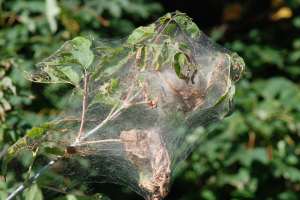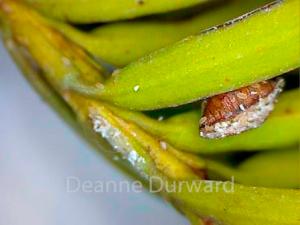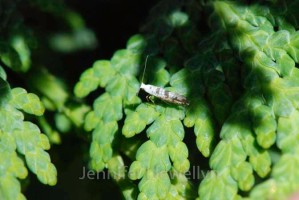Environment Canada is calling for ridiculously hot and humid weather until Wednesday where cooler temperatures and showers will return. UV index is very high so please take care out there are wear sunscreen, a hat and drink lots of fluids.
 Blood thirsty mosquitoes are thriving due to the frequent rains we’ve had. They breed in standing water and a new generation of adults can be produced in as little as 14 days. The GOOD NEWS is, there have been no reported human cases of West Nile Virus in Ontario this year (Public Health Ontario, July 12, 2014). The bad news is, the majority of mosquito genera recovered in Ontario right now are known for their insatiable appetite for our blood.
Blood thirsty mosquitoes are thriving due to the frequent rains we’ve had. They breed in standing water and a new generation of adults can be produced in as little as 14 days. The GOOD NEWS is, there have been no reported human cases of West Nile Virus in Ontario this year (Public Health Ontario, July 12, 2014). The bad news is, the majority of mosquito genera recovered in Ontario right now are known for their insatiable appetite for our blood.
Are you seeing white mould growing on the bark of deciduous trees, especially maple and beech?
Some scientists believe this mould growth is the fungal part of a lichen, without the algae.
 A lichen is made up of two organisms, a fungus and an algae that grow together as one organism on the surface of the bark of trees. As some of you may know, its a really good sign that lichen populations are increasing in southern Ontario because their presence indicates that our air quality is improving.
A lichen is made up of two organisms, a fungus and an algae that grow together as one organism on the surface of the bark of trees. As some of you may know, its a really good sign that lichen populations are increasing in southern Ontario because their presence indicates that our air quality is improving.
Plant Phenology indicators this week.
A) North of 401 (500-700 GDD Base 10oC): Daucus carota (wild carrot, full bloom), Hydrangea arborescens ‘Grandiflora’ (late bloom), Sambucus canadensis (full bloom), Yucca filamentosa (late bloom), Cichorium intybus (early bloom)
B) Niagara (700-900 GDD Base 10oC): Daucus carota (wild carrot, late bloom), Hydrangea arborescens ‘Grandiflora’ (late bloom to flowers starting to turn greenish), Sambucus canadensis (late bloom), Sorbus acucuparia (yellow fruit)
OMAFRA Publication 840, Crop Protection Guide for Nursery and Landscape Plants can be found at: http://www.omafra.gov.on.ca/english/crops/pub840/p840order.htm It contains the crop pest recommendations for nursery and landscape plants that was previously found in publication 383. Publication 840 is a .pdf file, accessible online and on cd.
 Nursery-Landscape Insect Pest ID: Dave Cheung’s Common Pests of Nursery-Landscape database to help ID your problem pests. Check it out !!!
Nursery-Landscape Insect Pest ID: Dave Cheung’s Common Pests of Nursery-Landscape database to help ID your problem pests. Check it out !!!
 OMAF publication 841, Guide to Nursery and Landscape Production and IPM, has now been posted to the website. It contains supporting information on crop production and maintenance in regards to nutrition, irrigation and integrated pest management (including plant phenology tables). To view the pdf, click here: www.ontario.ca/bwa5
OMAF publication 841, Guide to Nursery and Landscape Production and IPM, has now been posted to the website. It contains supporting information on crop production and maintenance in regards to nutrition, irrigation and integrated pest management (including plant phenology tables). To view the pdf, click here: www.ontario.ca/bwa5
EDUCATIONAL EVENTS:

1) Application Technology Expert, Dr. Jason Deveau. Jason is an expert in helping horticultural producers increase coverage and improve efficacy and this year, Jason is bringing his expertise to landscape and arboriculture. The OMAF Landscape Sprayer Workshop will be offered in September. Stay tuned for more details.
2) International Plant Propagator’s Society Eastern Region Annual Conference is coming up on September 17-20 in Niagara Falls this year. Area tours of nurseries, greenhouses and botanical gardens will be taking place on September 17 and September 19. Sign up for the entire conference or just the tours. Please go to IPPS Eastern Region Meeting 2014. Or click here for our promotional video.
PLEASE NOTE: The Following Pesticide Recommendations are meant for Exception Uses (e.g. agriculture) under the Cosmetic Pesticide Ban unless the active ingredient is listed under Class 11 pesticides in Ontario Regulation 63/09, effective April 22, 2009.
VARIOUS ORNAMENTALS:
 Euonymus scale is producing a SECOND generation of crawlers at this time. Look for tiny, orange crawlers in amongst the adult scale populations on leaves and stems. Crawlers are very susceptible to applications of contact insecticides, even insecticidal soap and the summer rate of dormant oil. Watch temperatures as some pesticides can burn foliage when its hot and humid out.
Euonymus scale is producing a SECOND generation of crawlers at this time. Look for tiny, orange crawlers in amongst the adult scale populations on leaves and stems. Crawlers are very susceptible to applications of contact insecticides, even insecticidal soap and the summer rate of dormant oil. Watch temperatures as some pesticides can burn foliage when its hot and humid out.


Are you seeing webbing around the ends of branches on deciduous trees such as ash, birch and cherry? Look inside the webbing and look for yellow, fuzzy caterpillars. These are fall webworm caterpillars and they usually start to show up on the ends of branches this time of year. Prune out nests and destroy them to prevent future colonies from infesting your trees. Pole loppers are an awesome tool for managing fall webworm caterpillar nests! Spraying is not necessary or necessarily effective unless there are high populations of nests.
Have white grubs been an issue in your nursery? Preventative applications of Intercept (imidacloprid) are registered for white grubs (nursery production) and the application period is in June and July (during the adult flight period for the adult stage). To help qualify for the Japanese beetle certification program, an application of Intercept 60WP on container stock or field stock should made between mid-June to July (adult flight period). The cut-off period for Intercept applications to comply with the JB Certification program this year is AUGUST 15. [Beneficial nematode applications for white grubs (e.g. European chafer) are not effective at this time].
Japanese beetle adults are flying and feeding on leaves of woody plants (Syringa, Tilia, Ulmus, Prunus, Rosa). Look for metallic, coppery-green beetles with white turfts of hairs along the edge of their abdomens.
Adulticide insecticides for JB in the nursery include Sevin XLR and Thionex. Pheromone traps for JB are extremely good at attracting the adults. Always place traps far AWAY (I mean away!) from susceptible host trees and shrubs (e.g. Rosa, Prunus, Tilia, Syringa, Ulmus etc.).
DECIDUOUS WOODY AND HERBACEOUS PERENNIALS:

 Seeing spots on apple and crabapple leaves? Leaf spots that can be found exclusively along leaf veins are likely apple scab (Venturia inaequalis). This disease causes a leaf spot and the tree’s response is to drop the infected leaves. Infected leaves often turn yellow and can be found on the ground under the trees. Mow fallen leaves to encourage their decomposition by bacteria and earthworms as a way of reducing disease inoculum next spring. Fungicide sprays for apple scab need to occur during leaf emergence in spring, it is too late to spray fungicides once leaf symptoms are visual. Water, aerate soils and fertilize affected trees to improve health.
Seeing spots on apple and crabapple leaves? Leaf spots that can be found exclusively along leaf veins are likely apple scab (Venturia inaequalis). This disease causes a leaf spot and the tree’s response is to drop the infected leaves. Infected leaves often turn yellow and can be found on the ground under the trees. Mow fallen leaves to encourage their decomposition by bacteria and earthworms as a way of reducing disease inoculum next spring. Fungicide sprays for apple scab need to occur during leaf emergence in spring, it is too late to spray fungicides once leaf symptoms are visual. Water, aerate soils and fertilize affected trees to improve health.
The leaf disease, Blumeriella jaapii, has been detected on fruiting Prunus (cherry, plum) this year. This leaf spot disease is more prevalent due to frequent rains and leaf wetness periods. Our nursery scout is also finding plum leaf blight as well (Coccomyces prunophorae). 
We have seen tons of powdery mildew on deciduous flowering shrubs (Amelanchier, Rosa, Physocarpus) and herbaceous perennials. Monitor for white, powdery residue on the tops and bottoms of leaves. Protect new foliage with fungicide applications [e.g. Switch, Milstop, Regalia (biofungicide), Tivano] but where the disease pressure is moderate to high, fungicides are not going to be effective.
 Magnolia scale adults are turning from white to pink-orange at this time. They will be laying their eggs under these protective shells and the eggs will start to hatch at the beginning of August or so. Pick the scale off and look for juicy flesh as a sign that egg-laying hasn’t happened yet. Eggs appear as tiny grains underneathe female bodies.
Magnolia scale adults are turning from white to pink-orange at this time. They will be laying their eggs under these protective shells and the eggs will start to hatch at the beginning of August or so. Pick the scale off and look for juicy flesh as a sign that egg-laying hasn’t happened yet. Eggs appear as tiny grains underneathe female bodies.
Injectable insecticides may be used to protect ash trees from new infestations of Emerald Ash Borer (Agrilus planipennis). Trees must be actively transpiring in order to maximize insecticide uptake into the cambium. Registered injectable insecticide products include: AceCap 97, Confidor 200 SL and Tree-Azin. Check out the Management Strategy for Emerald Ash Borer and Bronze Birch Borer at: http://www.omafra.gov.on.ca/english/crops/insects/eab-bbb-manage.htm.
Potato leafhoppers NYMPHS and ADULTS are still feeding on woody nursery stock on the newest growth. Monitor for potato leafhopper on nursery crops such as Caragana, and Acer (platanoides, saccharum). Nymphs are about 2 mm long and scuttle SIDEWAYS, rather quickly, across the leaf and to the other side (they don’t have wings to fly away). Susceptible crops are those that are flushing new leaves (leafhopper’s favourite food source). Older, hardened off foliage is not usually as susceptible. Leafhopper adults are winged, are very mobile, tiny, pale yellow-green jumping insects that are easily disturbed when you approach infested foliage. It almost looks as though they are being flicked off of the foliage. Leafhoppers (and aphids) suck plant sap from soft, expanding foliage and cause foliage to wilt, turn brown/black (‘Hopper Burn”) and become stunted and malformed. Older, hardened off foliage will become flecked from leafhopper feeding. Unfortunately, most of the damage has been done by now but where new growth is emerging, insecticides may be
Gypsy moth larvae are pupating and no longer susceptible to insecticides.
Sticky bands around trunks during the June/July flight period will help prevent adult female Gypsy moths from laying eggs above sticky bands and will attract males to the sticky surface. Pheromone-baited sticky traps are also available to help reduce populations of adult males.
Two-spotted spider mites (TSSM) are feeding on several types of deciduous woody (Viburnum and Spiraea in container production) and herbaceous perennials. Look for chlorotic leaves with stippling, use your hand lens to see tiny, clear bodied mites with dark regions (may be faint black) on their backs.

These mites are small but the damage is significant so catch them early. Miticides registered for this mite in the greenhouse include: DynoMite, Vendex, Kanemite, Floramite, Avid. Apollo is registered in outdoor nursery crops to knock down the egg stage and newly hatched nymphs. In the greenhouse, biocontrol agents should be brought in to coincide with the first sign of TSSM. Phytoseiulus persimilis is a predatory mite that feeds on TSSM when temperatures are below 26oC and it is a good choice when TSSM populations are low-moderate. Amblyseius californicus is a predatory mite that can be brought in ahead of TSSM appearance (because it can find other sources of food). Stethorus punctillium is a new beetle that is a good predator of TSSM.
EVERGREENS:
Taxus or Fletcher Scale crawlers (left) have settled on needles and twigs and are feeding (right). As they become older, they are more difficult to kill with insecticides. Several contact and systemic insecticides are registered for this pest in the nursery.

 Monitor for black vine weevil ADULTS in the FIELD and LANDSCAPE for Rhododendron, Taxus, Thuja and Euonymus. It’s too late for applications of nematodes in the field/landscape.Strawberry root weevil can also be a problem in field production of evergreens, adults have emerged. Signs of strawberry root weevil adults include brown, flagging shoot tips (and small girdling marks at the base of the flagged shoot) on Thuja (eastern white cedar). To scout for adult weevils, place a tarp or large piece of card board under the tree, shake branches vigorously and look for brown-black weevils “playing dead”. Insecticides for adult weevils in the nursery include Pounce, Sevin and Thiodan. Remember, adult weevils feed at night. Spray insecticides in late evening to target adults and reduce UV degradation (e.g. Pounce, Scimitar).
Monitor for black vine weevil ADULTS in the FIELD and LANDSCAPE for Rhododendron, Taxus, Thuja and Euonymus. It’s too late for applications of nematodes in the field/landscape.Strawberry root weevil can also be a problem in field production of evergreens, adults have emerged. Signs of strawberry root weevil adults include brown, flagging shoot tips (and small girdling marks at the base of the flagged shoot) on Thuja (eastern white cedar). To scout for adult weevils, place a tarp or large piece of card board under the tree, shake branches vigorously and look for brown-black weevils “playing dead”. Insecticides for adult weevils in the nursery include Pounce, Sevin and Thiodan. Remember, adult weevils feed at night. Spray insecticides in late evening to target adults and reduce UV degradation (e.g. Pounce, Scimitar).
Cedar leaf miner (CLM) next generation larvae are starting to hatch and feed on tender new foliage. A light sheering of tips in early August should give good knockdown of CLM larvae. Cygon is registered as a foliar application for CLM larvae in early August in the nursery.
 Monitor for nymphs and adults of spruce spider mite on conifers with a history of mite damage. Spruce spider mite nymphs and adults are brown with black backs and found on new foliage this time of year. Click HERE for a short video. Miticides registered for SSM include Floramite and Kanemite. Miticides may be required where pest pressure is moderate to heavy (container grown conifers with overhead irrigation). Populations in field production and in the landscape are usually not very active until the cooler weather returns in September.
Monitor for nymphs and adults of spruce spider mite on conifers with a history of mite damage. Spruce spider mite nymphs and adults are brown with black backs and found on new foliage this time of year. Click HERE for a short video. Miticides registered for SSM include Floramite and Kanemite. Miticides may be required where pest pressure is moderate to heavy (container grown conifers with overhead irrigation). Populations in field production and in the landscape are usually not very active until the cooler weather returns in September.
courtesy of Eric Carr Photography
Click here for a cool little video of a female ruby-throated hummingbird, recorded on an Ipad.
















